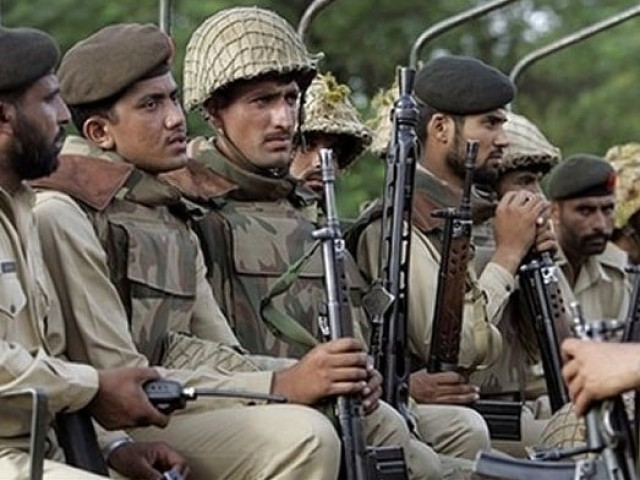Speaking of the average Pakistani officer of today, however, Lt General (retd) Tanvir Naqvi told me that, he has no doubt in his mind that the adversary is India, and that the whole raison d’etre of the Army is to defend against India. His image of Indians is of an anti-Pakistan, anti-Muslim, treacherous people. So he feels that he must be always ready to fight against India.
The military’s obsession with India and Kashmir is not in origin Islamist, but Pakistani Muslim nationalist. With rare exceptions, this has been true even of those senior officers most closely involved in backing Islamist extremist groups to fight against India, like former ISI chief Lt General Hamid Gul. Most have used the Islamists as weapons against India without sharing their ideology.
The Islamist radical groups, madrassas and networks which had served to raise Pakistani volunteers for the Afghan jihad had always hated India, and were only too ready to accept Pakistani military help, including funding, weapons supplies, provision of intelligence, and the creation of training camps run by the Pakistani military.
Finding a new enemy
However, just as in Afghanistan first the Mujahedin and then the Taliban escaped from the US and Pakistani scripts and ran amok on their own accounts, so the militants in Kashmir began to alienate much of the native Kashmiri population with their ruthlessness and ideological fanaticism; to splinter and splinter again into ever-smaller groups and fight with each other despite ISI efforts to promote co-operation, and to prey on Kashmiri civilians.
Finally – though it is not clear if this was really a departure from the script, ISI officers claim in private, (or was planned by the ISI as the Indian government believes) – the militants began to carry out terrorist attacks on Indian targets outside Kashmir (starting with an attack on Indian soldiers at the Red Fort in Delhi in December 2000). This last development in particular ensured that in the wake of 9/11, Pakistan would come under irresistible US pressure to abandon its active support for the Kashmiri jihad and crack down on its militant allies.
In January 2002, Musharraf formally banned Lashkar-e-Taiba and Jaish-e-Mohammed, and ordered an end to militant infiltration into Indian Kashmir from Pakistan. Due mainly to intense US pressure, from mid-2003 on this ban has been enforced, leading to a steep reduction in violence in Kashmir. Largely as a result, in November 2003 India and Pakistan agreed a ceasefire along the Line of Control in Kashmir, and initiated a dialogue on a possible settlement over Kashmir. However, the Pakistani military remained firmly convinced that India would never agree to terms even minimally acceptable to Pakistan unless at least the threat of future guerrilla and terrorist action remained present.
By 2008, as the Taliban insurgency against Pakistan itself gathered pace and an increasing number of ISI officers and informants fell victim to it, the ISI itself began to see the need for a new and much tougher approach to some of its militant allies within Pakistan.
However, the military is genuinely concerned that if it attacks some of these groups it will drive them into joining the Pakistani Taliban – as has already occurred with Sipahi-Sabah, Lashkar-e-Janghvi and some sections of Jaish-e-Mohammed. The suspected involvement of JeM activists in the attempts to assassinate Musharraf in December 2003 (apparently with low level help from within the armed forces) led to a harsh crackdown on parts of the group by Pakistani intelligence.
The ISI’s long association with the militants, first in Afghanistan and then in Kashmir, had led some officers into a close personal identification with the forces that they were supposed to be controlling. This leads to a whole set of interlocking questions: How far the Pakistani High Command continues to back certain militant groups; how far the command of the ISI may be following a strategy in this regard independent from that of the military; and how far individual ISI officers may have escaped from the control of their superiors and be supporting and planning terrorist actions on their own.
This in turn leads to the even more vital question of how far the Pakistani military is penetrated by Islamist extremist elements, and whether there is any possibility of these carrying out a successful military coup from below, against their own high command.
Since this whole field is obviously kept very secret by the institutions concerned (including Military Intelligence, which monitors the political and ideological allegiances of officers), there are no definitive answers to these questions.
What follows is informed guess-work based on numerous discussions with experts and off-the-record talks with Pakistani officers including retired ISI officers.
Concerning the ISI, the consensus of my informants is as follows:
There is considerable resentment of the ISI in the rest of the military, due to their perceived arrogance and suspected corruption. However, when it comes to overall strategy, the ISI follows the line of the high command. It is after all always headed by a senior regular general, not a professional intelligence officer, and a majority of its officers are also seconded regulars. The present Chief of Army Staff, General Ashfaq Kayani, was director of the ISI from 2004-2007, and ordered a limited crackdown on jihadi groups that the ISI had previously supported.
Cover-ups and connections
Concerning the Afghan Taliban, the military and the ISI are at one, and the evidence is unequivocal:
The military and ISI continue to give them shelter, and there is deep unwillingness to take serious action against them on America’s behalf, both because it is feared that this would increase Pashtun insurgency in Pakistan, and because they are seen as the only assets Pakistan possesses in Afghanistan. The conviction in the Pakistani security establishment is that the West will quit Afghanistan leaving civil war behind, and that India will then throw its weight behind the non-Pathan forces of the former Northern Alliance in order to encircle Pakistan strategically.
Concerning the Pakistani Taliban and their allies, however, like the military as a whole, the ISI is now committed to the struggle against them, and by the end of 2009 had lost more than seventy of its officers in this fight – some ten times the number of CIA officers killed since 9/11, just as Pakistani military casualties fighting the Pakistani Taliban have greatly exceeded those of the US in Afghanistan. Equally, however, in 2007-2008 there were a great many stories of ISI officers intervening to rescue individual Taliban commanders from arrest by the police or the army – too many, and too circumstantial, for these all to have been invented.
It seems clear therefore that whether because individual ISI officers felt a personal commitment to these men, or because the institution as a whole still regarded them as potentially useful, actions were taking place that were against overall military policy – let alone that of the Pakistani government. Moreover, some of these men had at least indirect links to Al Qaeda. This does not mean that the ISI knows where Osama bin Laden (if he is indeed still alive), Aiman al-Zawahiri and other Al Qaeda leaders are hiding. It does however suggest that they could probably do a good deal more to find out.
On the crucial question of support for terrorism against India, it is obvious that not just the ISI but the military as a whole are committed to keeping Lashkar-e-Taiba (under its cover as Jamaat-ut-Dawa) at least in existence, both as a potential future weapon against India and because they are genuinely scared of driving this very powerful and popular group to revolt.
Jamaat-ut-Dawa’s extensive international network in the Pakistani diaspora also leads Pakistani officers to fear that if they attempt seriously to suppress the group it will also launch successful terrorist attacks in the West, with disastrous results for Pakistan’s international position. Lashkar-e-Taiba members certainly have contacts with Al Qaeda, and have helped the groups operatives escape from Afghanistan after the defeat of the Taliban and helped shelter them within Pakistan. As Stephen Tankel writes,
Ideologically, for all of its strategic restraint following 9/11 Lashkar is, after all, a jihadi organization with a long history of waging pan-Islamic irredentist campaigns. Indian-controlled Kashmir may be the group’s primary ideological and strategic target, but it has never been the apotheosis of Lashkar’s jihad.
All the groups and individuals within this net hate the US, Israel, India and indeed Russia alike, though they have different targets at different times. Despite LeT’s strategic decision to concentrate on India, therefore, there is no ideological barrier to its members taking part in actions against the West. The jihadi world could even be called a kind of cloud of gas in which individuals join some clump for one operation and then part again to form new ad hoc groups for other attacks. This also makes it extremely hard for the ISI to keep tabs on the individuals concerned, even when it wants to.
Creating a monster
By far, the biggest terrorist attack actually carried out by LeT itself was that in Mumbai in November 2008. The great majority of the Pakistani experts and retired officers whom I know do not think that the Pakistani high command, either of the ISI or the army, was involved in ordering Lashkar-e-Taiba’s terrorist attack on Mumbai in November 2008. They point out in particular that while deliberately targeting Westerners greatly boosted LeT’s prestige among international militants, it would have been an unprecedented, reckless and pointless strategy for the Pakistani high command, ensuring a furious reaction from the international community.
Equally, there is an overwhelming consensus that this operation could not have been planned without ISI officers having been involved at some stage and without the ISI knowing that some sort of operation was being planned. Whether the operation then continued as it were on autopilot, was helped only by retired officers, or whether the junior officers concerned deliberately decided to pursue it without telling their superiors, is impossible to say at this stage.
ISI help is however not necessary for Islamist terrorists who wish to carry out attacks against India (though it has certainly occurred in the past). The discontent of sections of India’s Muslim minority (increased by ghastly incidents like the massacres of Muslims in Gujarat in 2002, encouraged by the Hindu nationalist state government) gives ample possibilities of recruitment; the sheer size of India, coupled with the incompetence of the Indian security forces, gives ample targets of opportunity; and the desire to provoke an Indian attack on Pakistan gives ample motive. But whether or not the ISI is involved in future attacks, India will certainly blame Pakistan for them.
This creates the real possibility of a range of harsh Indian responses, stretching from economic pressure through blockade to outright war. Such a war would in the short term unite Pakistanis, and greatly increase the morale of the Army. The long term consequences for Pakistan’s (and possibly India’s) economic development could however be quite disastrous; while if the US were perceived to back India in such a war, anti-American feeling and extremist recruitment in Pakistan would soar to new heights. All of this gives the US every reason to press the Pakistani military to suppress some extremist groups and keep others on a very tight rein. Washington also however needs to press India to seek reconciliation with Pakistan over Kashmir, and to refrain from actions which will create even more fear of India in the Pakistani military.



COMMENTS
Comments are moderated and generally will be posted if they are on-topic and not abusive.
For more information, please see our Comments FAQ